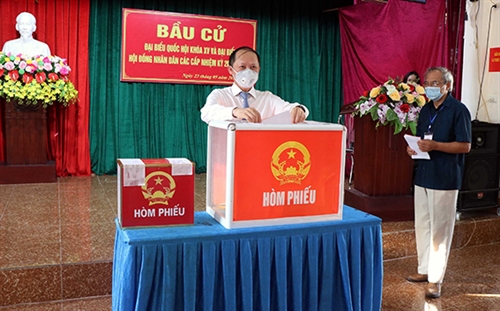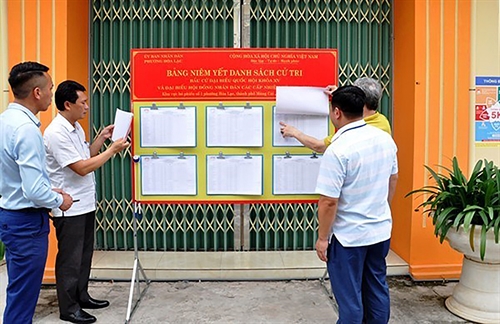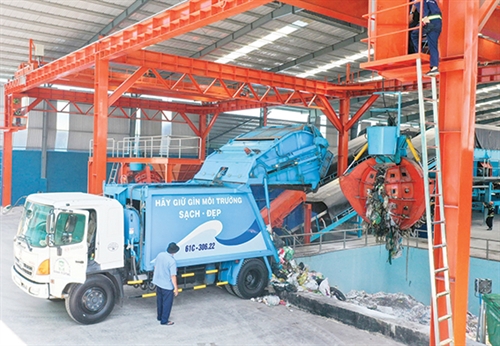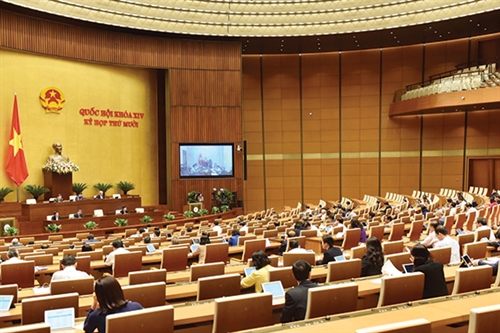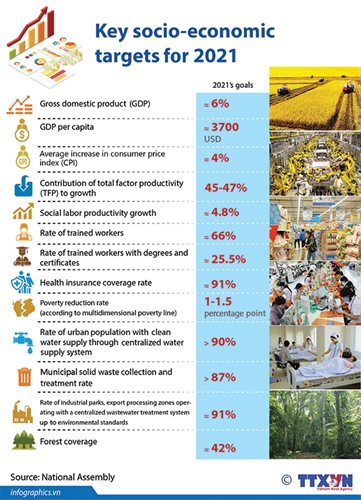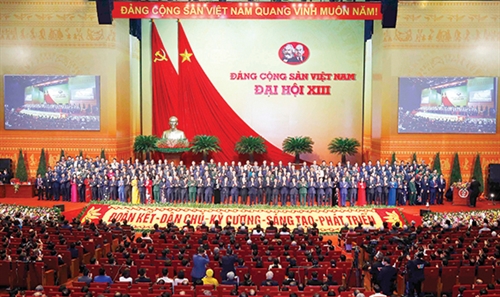Center for Community Support and Development Studies,
Vietnam Fatherland Front Center for Research and Training, and United Nations Development Program
The 2020 Vietnam Provincial Governance and Public Administration Performance Index (PAPI) Report,[1] released on April 14, 2021, assesses citizen experiences with national and local government performance in governance, public administration, and public service delivery at the provincial level, apart from a national overview[2]. Similar to previous iterations, the 2020 PAPI Report presents detailed findings on how provinces performed across the eight PAPI dimensions (Participation at Local Levels, Transparency in Local Decision-making, Vertical Accountability Toward Citizens, Control of Corruption in the Public Sector, Public Administrative Procedures, Public Service Delivery, Environmental Governance, and E-Government), as well as in the aggregate PAPI scores for all 63 provinces.
Overall, in 2020, none of the 63 provinces were in the top performing group across all eight dimensions. In addition, the 2020 PAPI Report provides detailed findings within sub-dimensions and indicators for each province. It strongly recommends that deeper dives into these findings, rather than just comparing aggregate dimension scores, be key for those provinces that wish to respond to their citizens’ concerns and expectations effectively.
This article is an excerpt from the 2020 PAPI Report and presents key findings about how provinces performed in 2020 by each dimension and by the aggregate 2020 PAPI scores.
 |
| A conference held to review the state administrative reform program during 2011-20 in Lao Cai province on June 25, 2020__Photo: Quoc Khanh/VNA |
Dimension 1: Participation at Local Levels
Participation in political, social and economic life is the constitutional right of all Vietnamese citizens from the age of 18. Such participation is important for citizens to exercise their democratic rights and do their part to help improve local governance. Eight provinces made significant progress in 2020 in Dimension 1, with Thai Nguyen being the most remarkable improver compared to 2019. More than half of all provinces, however, witnessed declines in this dimension.
The sub-dimension on Quality of Village Head Elections contributes the most to provinces’ overall scores in Dimension 1. Hoa Binh was the best performing province in this sub-dimension, while Soc Trang was the poorest performing province.
On the Citizen Participation in Decision-making to Start a Local Infrastructure Project indicator, Quang Ninh, An Giang and Ca Mau made the largest improvement in 2020, compared to 2016. Yen Bai and Thai Nguyen performed well in both 2016 and 2020. Da Nang, Binh Duong and Hai Duong saw the largest drops, while Kien Giang was the poorest performer in both 2016 and 2020.
Dimension 2: Transparency in Local Decision-making
In Dimension 2, PAPI measures how local governments facilitate access to government information and respond to civic rights in the four sub-dimensional areas of Access to Information, Transparency in Poverty Lists, Transparency in Commune Budget and Expenditure, and Transparency in Local Land Use Planning and Pricing.
Twelve provinces made significant progress in 2020, compared to 2019, in their efforts to make local decision-making in the four sub-dimensions transparent. Binh Dinh and Thai Nguyen saw the largest positive change. However, 11 provinces experienced significant setbacks, with Soc Trang and Binh Duong seeing the largest declines.
Provincial performance in the Transparency of Poverty Lists sub-dimension contributes the most to Dimension 2 scores. Thai Nguyen, Ba Ria-Vung Tau and Quang Ninh scored above 2 points, while Lam Dong and Khanh Hoa scored low at 1.4 points on a 0.25-2.5 point scale. Provincial performance in the Access to Information sub-dimension was the poorest among the four sub-dimensions. Thai Nguyen scored the highest, but only at 1.04 points, while An Giang scored the lowest at 0.69 point.
On provincial performance in disclosing local land plans, as shown in Figure 1, two-thirds of provinces made some improvement in making local land plans accessible in 2020, compared to 2016. However, the proportion of citizens being aware of local land plans remains low at below 45 percent across all provinces. While some provinces (e.g., Quang Ninh, Bac Giang and Lang Son) made large progress in land plan transparency, provinces like Vinh Long, Ninh Binh and Phu Tho saw a huge decline in the proportion of respondents saying that they were aware of the plans over four years.
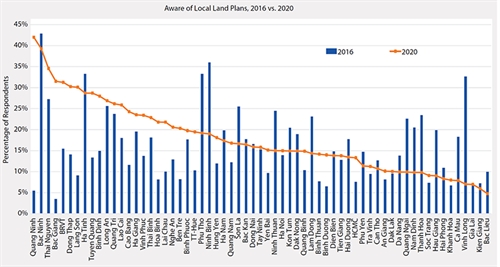 |
 |
Dimension 3: Vertical Accountability Toward Citizens
Dimension 3 reflects how local governments respond to citizen requests, proposals, denunciations, complaints and/or petitions. It consists of three sub-dimensions, including Interactions with Local Authorities, Government Responsiveness to Citizen Appeals, and Access to Justice Services.
Twelve provinces made significant progress in this dimension in 2020 compared to 2019, with Vinh Long and Tien Giang making the most headway. Meanwhile, 12 provinces saw significant declines, with Quang Ngai experiencing the largest drop.
The Interactions with Local Authorities sub-dimensional scores contribute the most to the dimension aggregate. Tien Giang, Ben Tre, Ca Mau, Dong Thap and Binh Duong are the top five performers in this sub-dimension. On the other hand, the Government Responsiveness to Citizen Appeals sub-dimension contributes the least to the overall Dimension 3 scores. Soc Trang, Hai Phong, Khanh Hoa, Da Nang and Binh Duong are the five poorest performers in this sub-dimension.
Dimension 4: Control of Corruption in the Public Sector
This dimension measures the performance of public institutions and local governments in controlling corruption in the public sector and reflects citizens’ tolerance of corrupt practices. It consists of four sub-dimensions: Limits on Corruption in Local Governments, Limits on Corruption in Public Service Delivery, Equity in State Employment, and Willingness to Fight Corruption.
As many as 18 provinces made significant progress in 2020 to control corruption in the public sector, compared to 2019. As in previous years, Ben Tre performed well in this dimension. Six provinces experienced significant setbacks, with Ninh Thuan and Ninh Binh seeing the largest declines.
Nine out of the top 10 performers in controlling corrupt behaviors are central and southern provinces. As shown in Figure 2, Quang Ninh, Dong Thap, Ben Tre, Quang Tri and Quang Nam are the top five performers in this indicator. On the other hand, corrupt behaviors were found most often in Lam Dong, Hai Phong, Khanh Hoa, Ninh Binh and Kon Tum.
Note: Scale: from 0 to 6 points, with 6 the best score; arranged in order from lowest to highest values in the No Bribes for State Employment criteria.
Also, compared to 2016, personal relationships have become less important in all provinces, implying that local governments may have paid greater attention to a fair recruitment of state employees. However, personal relationships remain important for five public offices at the commune level, even among the top performers, so are bribes for state employment.
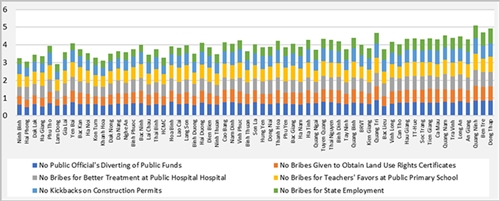 |
 |
Dimension 5: Public Administrative Procedures
This dimension reflects the quality of four public administrative services, including certification services by local governments, application procedures for construction permits handled at the district level, application procedures for land use rights certificates, and application procedures for personal documents handled by commune governments. The dimension examines how professional and responsive local government staffs are in providing public administrative services.
Four provinces (Bac Ninh, Dong Thap, Binh Thuan and Thai Nguyen) made some progress in 2020 in this dimension (see Figure 3). Only Tien Giang and Can Tho performed worse in 2020 compared to 2019.
Most provinces (except Hai Phong, Thai Binh, Hoa Binh and Bac Ninh) made progress in the service they provide in relation to land use rights certificates. In addition, most provinces improved commune-level administrative procedures for individuals. Displaying service charges was the most significant positive change in 2020 compared to 2016. Nonetheless, the competence of public employees when handling administrative procedures at the commune level remains a problem for one-third of all provinces, especially in Khanh Hoa, Lai Chau, Dien Bien, Binh Dinh, Gia Lai and Can Tho.
 |
| Changes in performance in public administrative procedures (2019-2020, a change of ±5% defined as statistically significant) |
Dimension 6: Public Service Delivery
Dimension 6 looks at four public services: health care, primary education, basic infrastructure, and law and order. To explore this dimension, citizens are asked about their experience of the accessibility, quality and availability of these services.
Only four provinces (Binh Dinh, Khanh Hoa, Kon Tum and Gia Lai) made significant progress in Dimension 6 in 2020 compared to 2019. Meanwhile, 21 provinces saw significant declines, with the most significant setbacks seen in Ca Mau, Ninh Thuan, Dong Nai and Ben Tre.
Most provinces performed well in public health care. However, in terms of quality of public district hospitals, a lack of hospital beds remains the most problematic issue facing all provinces.
In relation to public primary schools, half of all provinces received higher scores in 2020 for school infrastructure and the facilities provided (such as brick wall classrooms, clean toilets, free drinking water, and less than three shifts of classes). Lang Son, Ha Tinh, Bac Kan, Phu Tho and Dien Bien had the highest score in this indicator. Still, most provinces continued to face issue with overcrowded classes and teachers who favorize students that attend extra classes.
Dimension 7: Environmental Governance
This dimension reflects citizens’ assessment of air and water quality, as well as the integrity of both local governments and businesses in protecting the environment. It sets some baselines to assist local governments in understanding environmental concerns over time.
Eleven provinces made significant progress in environmental governance in 2020 compared to 2019, with Thai Nguyen, Quang Ngai, Hoa Binh and Ha Nam improving the most. Dong Thap was the only province with an above average score of 5.2 points, on a scale from 1 to 10 points. At the other end of the scale, Hanoi, Ho Chi Minh City, Hai Phong and Da Nang are in the poorest performing group, as are the provinces of Binh Duong, Bac Ninh, Hung Yen, Thai Nguyen, Vinh Phuc and Lam Dong.
On the Air Quality sub-dimension, Quang Ninh, Ha Giang, Dien Bien, Bac Kan and Thanh Hoa were the top five provinces, despite their very modest scores. Among the poorest performers are Hung Yen, Ha Nam, Ho Chi Minh City, Lam Dong, Hanoi and Phu Tho.
Binh Duong, Bac Ninh, Hung Yen, Hanoi, Ho Chi Minh City, Phu Tho and Lam Dong were also provinces with fewer respondents seeing no incidences of firms paying bribes to avoid environmental responsibility over the two years of 2019 and 2020 (see Figure 4).
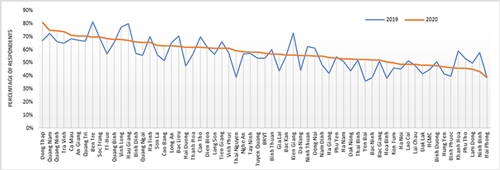 |
 |
Dimension 8: E-Governance
This dimension, further refined in 2020, provides information about the availability of local government portals, access to e-government services and whether citizens have Internet access - the enabling environment for citizens to participate in e-government.
All provinces received low scores in this dimension. The poorest performing provinces were diverse, including the Mekong Delta (e.g., Tien Giang), central coast (e.g., Khanh Hoa) and mountainous provinces (e.g., Dien Bien and Son La).
Access to the Internet improved in most provinces in 2020 compared to 2019. Yet there remains a large divide between access to the Internet and access to local e-government portals for administrative services. As shown in Figure 5, over the two years, not much changed in terms of access to e-government portals. Bac Ninh, Ha Tinh, Quang Ngai, Kon Tum and Vinh Long saw large, but still modest, improvements in the provision of this access.
 |
 |
Aggregate 2020 PAPI scores for 63 provinces
Figure 6 provides an overview of aggregate performance across provinces, calculated by adding up each province’s scores in the eight PAPI dimensions. It allows provinces to assess how they perform relative to other provinces with similar socio-economic and geographic endowments.
The analysis shows that none of the 63 provinces were in the top performing group in all eight dimensions in 2020. Most of the better performing provinces are located in the north and central regions, while poorer performing provinces are found in the Northwest, Central Highlands and South Central Coast regions.
One province (Thai Nguyen) made significant progress in six dimensions, two provinces (Bac Ninh and Binh Dinh) in five dimensions, and three provinces (Hanoi, Hai Phong and Dong Thap) in four dimensions. In the meantime, one province (Can Tho) had a significant setback in five dimensions, while six provinces (Son La, Khanh Hoa, Ninh Thuan, Lam Dong, Binh Duong and Ben Tre) saw significant drops in four dimensions.
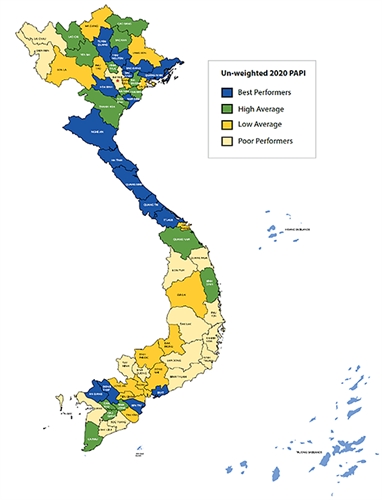 |
| Provincial Performance in Governance and Public Administration by Quartiles, 2020 |
However, any provincial government that wishes to respond to their citizens’ expectations effectively should look into each indicator to review their 2020 performance and seek measures to address setbacks in 2021 and the 2021-26 government term.-
